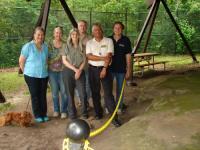On June 26, 2011, nine of us who had come together for the WAC Inter-Congress in Indianapolis drove seven hours north to the Isabella Reservation of the Saginaw Chippewa Indian Tribe of Michigan to visit the Ziibiwing Center of Anishinabe Culture and Lifeways, home to one of the first community-based studies funded by IPinCH.
On the trip representing IPinCH were George Nicholas, Susan Rowley, Julie Hollowell, Anne Pyburn, and Stephen Loring. Also making the journey were Jordan Wilson (UBC student and member of the Musqueam Indian Band), Paul Tapsell (Director of Maori Studies at Otago University, NZ), Jessie Ryker-Crawford (Institute of American Indian Arts, Santa Fe), and archaeologist Joan Gero, along with Stephen and Joan’s dog, Jack.
Ziibiwing’s Assistant Director Judy Pamp and her son opened the Center on a Sunday afternoon exclusively for our group, and then treated us to an individualized tour of this amazing facility. We literally spent hours in “Diba Jimooyung: Telling Our Story,” whose extensive exhibits reflect enormous care, intentionality, and multi-layered research concerning the Saginaw Chippewa’s past, present, and future. Clearly this is a place constructed by, for, and with Saginaw Chippewa people, while also serving as a regional attraction and an educational institution for everyone.
After a restful night, our caravan was led two hours eastward by Ziibiwing’s curator, William Johnson, to Sanilac Petroglyphs State Park, located just a few miles from Saginaw Bay in the “thumb” of Michigan. William (or Willie, as he prefers) and Ziibiwing’s director, Shannon Martin, serve as co-developers of this community-based study, along with IPinCH co-investigator Sonya Atalay, who is Anishinabe Ojibwe and an archaeologist at Indiana University-Bloomington. A short hike through the beautiful woods ended at a tall chain-link fence surrounding ezhibiigaadek asin, a huge rock whose many petroglyphs were exposed in 1881 as the result of a major fire. A few years ago, funding cuts in Michigan’s Department of Natural Resources (DNR) led to the state’s inability to properly safeguard or interpret the petroglyphs, known as ezhibiigaadek asin, and the fence was built, although trails in the surrounding forest remain open. The DNR approached the Saginaw Chippewa Indian Tribe about co-managing the site, which prompted discussions among tribal members concerning appropriate ways to interact with the site and share its important teachings. For several years now, members of the tribe have performed annual ceremonies at the petroglyphs.
Funding from IPinCH is aiding Ziibiwing—the tribe’s center for heritage research—to meet with spiritual leaders, elders and other tribal members, as well as officials from the DNR, to work toward developing a co-management agreement that takes into account the site’s intellectual properties—images, stories, lifeways, ceremonies, interpretations, research data, et cetera. It was fascinating to visit ezhibiigaadek asin and witness firsthand the significance of the petroglyph and its teachings. George Nicholas remarked that one of the first indicators that the Tribe is truly co-managing the site will come when they have their own key to the 12-foot fence, rather than needing to call the DNR to come and open it for them. After a bag lunch prepared for us by Ziibiwing (with lots of extra goodies!), we headed back to Indiana, stopping for a night on Lake Maxinkuckee.
All of us extend a gracious thanks to Shannon, Willie, Judy, and everyone at Ziibiwing for hosting us for this exciting and educational visit.
This article first appeared in the IPinCH Newsletter vol. 3.1+2 (Spring 2012)






